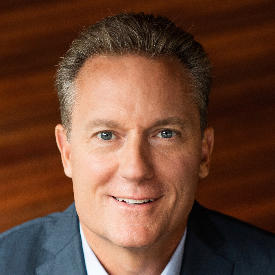Rich Horwath is the founder and CEO of the Strategic Thinking Institute where he serves leadership teams as a strategy workshop facilitator, executive coach, and strategic advisor. He is also a keynote speaker and a New York Times and Wall Street Journal bestselling author.
Below, Rich shares five key insights from his new book, Strategic: The Skill to Set Direction, Create Advantage, and Achieve Executive Excellence. Listen to the audio version—read by Rich himself—in the Next Big Idea App.

1. Watch your radar.
A key to successfully navigating your business is having a trigger to cause you to take note of and record the changes in your business situation. Where do you currently record the key factors influencing the context of your business? For many leaders, the answer is that all of these factors are constantly floating around in their head, taking up valuable mind space. The key is to find a single repository where you can record these factors to free up your thinking and have them in a single spot to review.
Radar is a method of detecting objects and determining their positions, velocities, or other characteristics using high-frequency radio waves reflected from their surfaces. In a similar fashion, the Contextual Radar can provide a visual snapshot of the key factors in the four primary areas of your business: market, customers, competitors, and company.
Market represents the patterns and trends that are influencing your business—perhaps industry consolidation or the introduction of generative AI. Customers are those you serve and can be both internal, such as business units and functional areas, and external, including clients or board of directors. Competitors represent the activities and offerings of other viable ways of meeting customer’s needs. Within the competitive landscape, we’ll want to note the significant activities of both traditional and non-traditional competitors. This includes initiatives, issues, and events within the organization, such as the implementation of a new CRM system, evolving culture, or flattening the organizational hierarchy. Look to update your Contextual Radar on a monthly basis to monitor changes in your business to stay ahead of the curve.
2. Increase insight velocity.
An insight is a learning that leads to new value. One reason so many organizations struggle to break free from the gravitational force of market mediocrity is because they are using dead plans. A dead plan is one that is not updated with new thinking and insights. Insight velocity is at the core of the recent domination of the Formula One (F1) international racing series by the Red Bull Racing team.
“Many organizations struggle to break free from the gravitational force of market mediocrity is because they are using dead plans.”
Red Bull Racing’s recent success is in part attributable to areas where they’ve gained insights that others lack. For example, they’ve designed an innovative bulbous shaped central section of the diffuser which has helped decrease the pressure of the downstream airflow. In plain English, that means the car has less drag and their DRS (Drag Reduction System) performance has competitors such as Ferrari trying to copy it in hopes of catching up. It’s important to remember that insight velocity drives your evolutionary velocity—the ability to understand, adapt, and thrive in the current environment.
On a scale of one to five with one being a snail and five being an F1 car, what would you rate your team’s insight velocity—your ability to take new learnings and convert them into actionable value that leads to advantage? Consider ways your organization can accelerate the flow of insights be creating accountability for both generating and sharing them across business units and functions.
3. Train your mind.
A physical workout can build muscle, improve cardiovascular health, increase energy, and generate other powerful benefits. However, it takes discipline, commitment, and a plan to improve your physical fitness. The same is true for your mind, and the exciting news is that by incorporating a regular mental workout into your routine, you’ll be in rare air.
A mental workout strengthens your leadership muscles by providing you with a framework to ride the waves of challenges that continuously roll through your calendar. The mental workout can be completed in five minutes and includes the following three core steps:
The first step includes performance statements, which are three to five keys to optimal performance (e.g., “I bring my undivided attention to meetings and do not multitask while others are talking.”). The second step involves visualization. Visualization means recalling positive recent events in detail, including the sights and sounds, and imagining upcoming events and the way you’d like them to play out. The final step is making personal statements. Your personal statements should include one to three phrases that encapsulate your best self at work (e.g., “I am a good listener and ask thoughtful questions without judging others in order to best meet their needs.”).
4. Lead at your level.
When you set strategic direction, the process of resource allocation inherently follows. A key component in effectively allocating resources into a unique system of activities to outperform the competition—strategy—is decision making. The speed of decision making is critical to both individual and organizational success. A study of 17,000 CEOs found that for those who rated low on decisiveness, 94 percent scored poorly because they were too slow in making decisions.
“Weighing in on decisions that are not at your level rob you of the time to focus on the decisions that truly matter.”
One reason executives are slow to make decisions is because they’re making too many decisions in the first place. Weighing in on decisions that are not at your level rob you of the time to focus on the decisions that truly matter and that only you can make. Jeff Bezos, founder of Amazon said, “As a senior executive, what do you really get paid to do? You get paid to make a small number of high-quality decisions. Your job is not to make thousands of decisions every day.” Leading at your level begins by creating an inventory of important decisions, ensuring decision rights are clear, and giving others the authority, resources, and accountability to make them.
5. Batch your work.
A technique popular with some of the most productive leaders in the world is batching. Batching is the act of processing similar items together and can save significant energy and bandwidth by dramatically reducing the number of transitions you have during your day. In the case of Jack Dorsey, who was simultaneously leading two large organizations (Twitter and Square), he would batch his time in larger chunks such as half-days and full days. He explained, “I theme my days. On Monday, at both companies, I focus on management and running the company. Tuesday is focused on product. Wednesday is focused on marketing and communications and growth. Thursday is focused on developers and partnerships. Friday is focused on the company and culture and recruiting. Saturday, I take off. Sunday is reflection, feedback, strategy and getting ready for the week.”
Prior to batching your work, it’s valuable to identify where you are currently investing your time. For one week, record where you’re spending your time in 30-minute increments. At the end of the week, categorize the time investments and calculate the total amount of time spent in each area. It’s helpful and enlightening to then visualize the summary by graphing your time investment, with the areas or categories of time on the horizontal x-axis and hours invested on the vertical y-axis. Compare your time investments with your priorities and determine how much time you’re investing in the most important areas and calibrate accordingly.
Elite executive performance requires the discipline to practice strategic fitness—applying tools and techniques to generate a flow of continuous learnings that result in your ability to provide superior value. After all, practice makes profit.
To listen to the audio version read by author Rich Horwath, download the Next Big Idea App today:
































